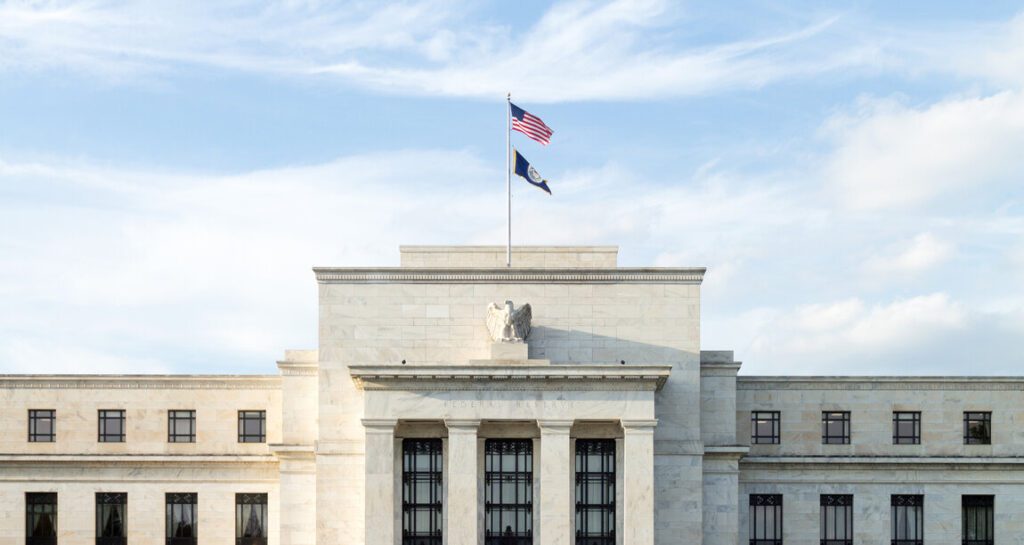The Federal Reserve raised the fed funds rate by 0.25 percentage points after its May 2023 meeting – its tenth increase since last March. The Group’s policy rate is now in the range of 5.00 – 5.25 per cent.
Mortgage rates fell after the Fed’s announcement.
The divergence of the fed funds rate and 30-year mortgage rates is a dire reminder: The Federal Reserve doesn’t set mortgage rates. Mortgage rates are made on Wall Street.
Here’s what to know.
What is the Federal Reserve?
The Federal Reserve is the government’s central bank and monetary policy agency, established in 1913 by the Federal Reserve Act.
Often called “the Fed”, the central banker is independent and operates without influence from Congress or the White House.
The primary role of the Fed is to maintain the stability and security of the US financial system, which it fulfills with the following duties:
- Supervision and regulation of US banks
- Management of the country’s money supply
- Acting as a lender of last resort during financial crisis
The group is remembered for three notable economic interventions:
- Early 1930s: With the FHA, the Fed helped the country emerge from the Great Depression
- Early 1980s: The Fed tames inflation by raising interest rates sharply and decisively
- 2008–2012: The Fed lowered interest rates to prevent a collapse of the financial system.
The Fed’s charter gives it several tools to influence the economy. Its primary tool is the fed funds rate.
The fed funds rate is the interest rate set for overnight loans between two banks.
The fed funds rate is the basis for other interest rates, including the prime rate, which is three percent above the fed funds rate.
The prime rate is the basis for business and consumer loans, including credit card rates and home equity lines of credit.
how does the fed funds rate work
The fed funds rate is the interest rate set by the Federal Reserve. It is used when banks borrow money from each other overnight.
Raising and lowering the fed funds rate speeds up and slows down economic growth, respectively. This is how it works.
A lower fed funds rate lowers the interest cost on loans between banks, making it cheaper for banks to borrow money. When banks pay less interest, they have more money available for business and consumer loans, which creates additional spending, jobs and economic growth.
Lowering the fed funds rate is expansionary. It also promotes inflation.
A higher fed funds rate does the opposite. When the Fed raises the fed funds rate, it makes it more expensive for banks to borrow money, which leads to less credit to American businesses and consumers, which slows economic growth.
Raising the fed funds rate is contractionary on the economy. It reduces inflation.
Get a pre-approved mortgage today.
When does the fed funds rate change?
The Federal Reserve has a 12-member committee called the Federal Open Market Committee (FOMC).
The FOMC meets at least eight times a year to discuss and update monetary policy.
At each meeting, the FOMC votes on whether to raise, lower, or leave the fed funds rate in order to regulate the pace of the economy.
The FOMC also meets on an emergency basis to change the fed funds rate, as it did on the following dates:
- October 8, 2008 (Banking crisis): Fed funds rate cut by 50 basis points
- March 3, 2022 (COVID): Fed funds rate cut by 50 basis points
- March 15, 2022 (COVID): Fed funds rate cut by 100 basis points
Through 2022, the FOMC has raised the fed funds rate tenfold. Its most recent increase on May 3, 2023, raised the benchmark rate to a range of around 5.00%, the highest fed funds rate in 16 years.
When is the next FOMC meeting?
The Federal Open Market Committee meeting schedule is listed on the Federal Reserve website. The group meets for two days, roughly six weeks apart, at the group’s Washington, D.C. headquarters.
There are eight scheduled meetings per year.
The next FOMC meetings are scheduled for:
- June 13-14, 2023
- July 25-26, 2023
- September 19-20, 2023
- October 31-November 1, 2023
- December 12-13, 2023
The 2024 FOMC meeting schedule has not yet been made available.
Click for mortgage pre-approval.
Federal Reserve and US mortgage rates
The Federal Reserve sets the fed funds rate. It does not create mortgage rates for first-time home buyers or set the interest rates that lenders charge buyers.
For example, if you were looking for today’s mortgage rates to buy your first home, you wouldn’t look to the Federal Reserve—you’d look to a mortgage company.
One could argue that the Federal Reserve doesn’t care what mortgage rates are. Mortgage lending is not part of the Fed’s charter, and making mortgages affordable is not on its to-do list.
The chart above highlights the separation between the fed funds rate and 30-year fixed-rate mortgage rates since 2000. If the rates were related, the lines would move.
They don’t move together because the Fed doesn’t set mortgage rates.
However, because mortgage rates react to inflation rates, the Federal Reserve and mortgage rates are not completely disconnected.
Click for mortgage pre-approval.
Inflation Vs. mortgage rates
Inflation is the devaluation of the US dollar.
As consumers, we perceive inflation as rising prices; We buy things and need more dollars to buy the same goods or services.
Wall Street perceives inflation differently. Inflation devalues investments, and inflation is one of the most powerful forces on US mortgage rates.
The inflation/mortgage rate relationship is direct:
- When inflation rises, mortgage rates usually rise.
- When inflation is falling, mortgage rates usually fall.
Inflation is the enemy of low mortgage rates, and as such, the Federal Reserve influences how mortgage rates move.
When the Federal Reserve signals that inflationary pressures are rising, mortgage rates tend to rise in response. Home buyers experienced this in late 2022 and early 2023, with mortgage rates rising by 7 percent.
Then, in mid-2023, when inflation starts to slow, mortgage rates go back down.
The Federal Reserve signals its future policy moves. First-time buyers can get lower mortgage rates by listening to what the Fed says instead of waiting for what it says.
The Fed controls inflation, and inflation controls rates.

mortgage
prior approval
in minutes





